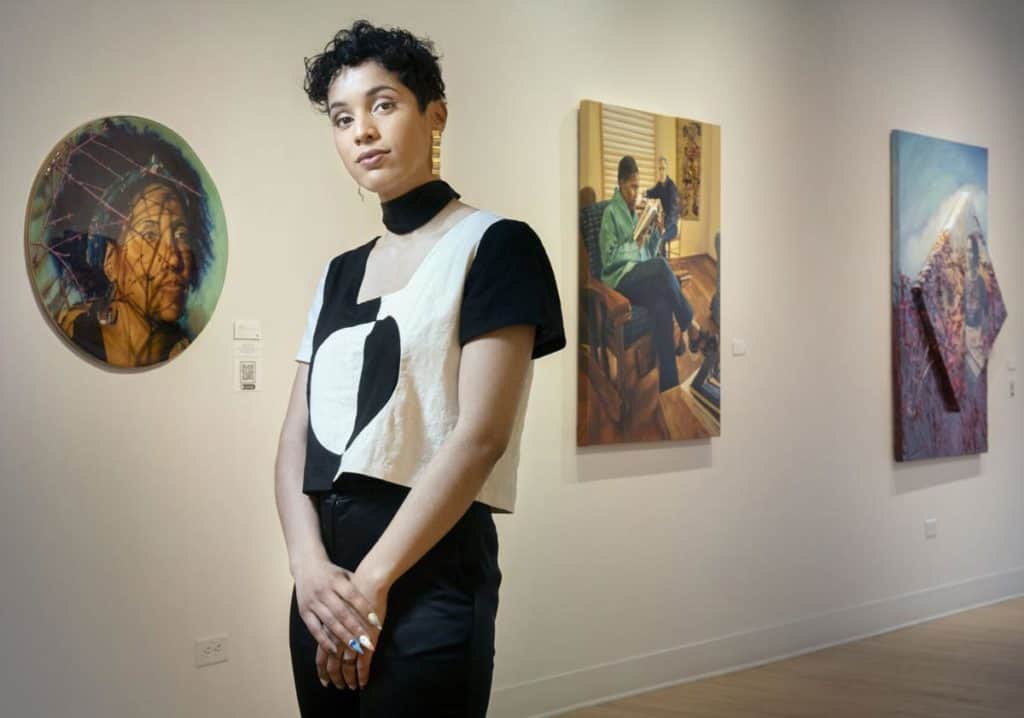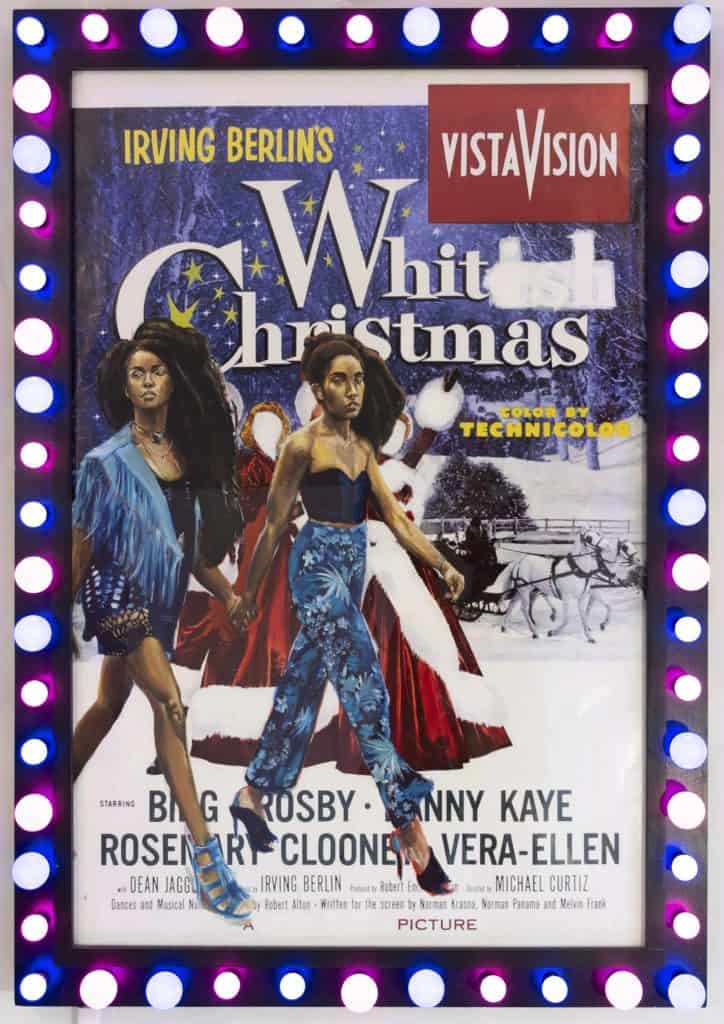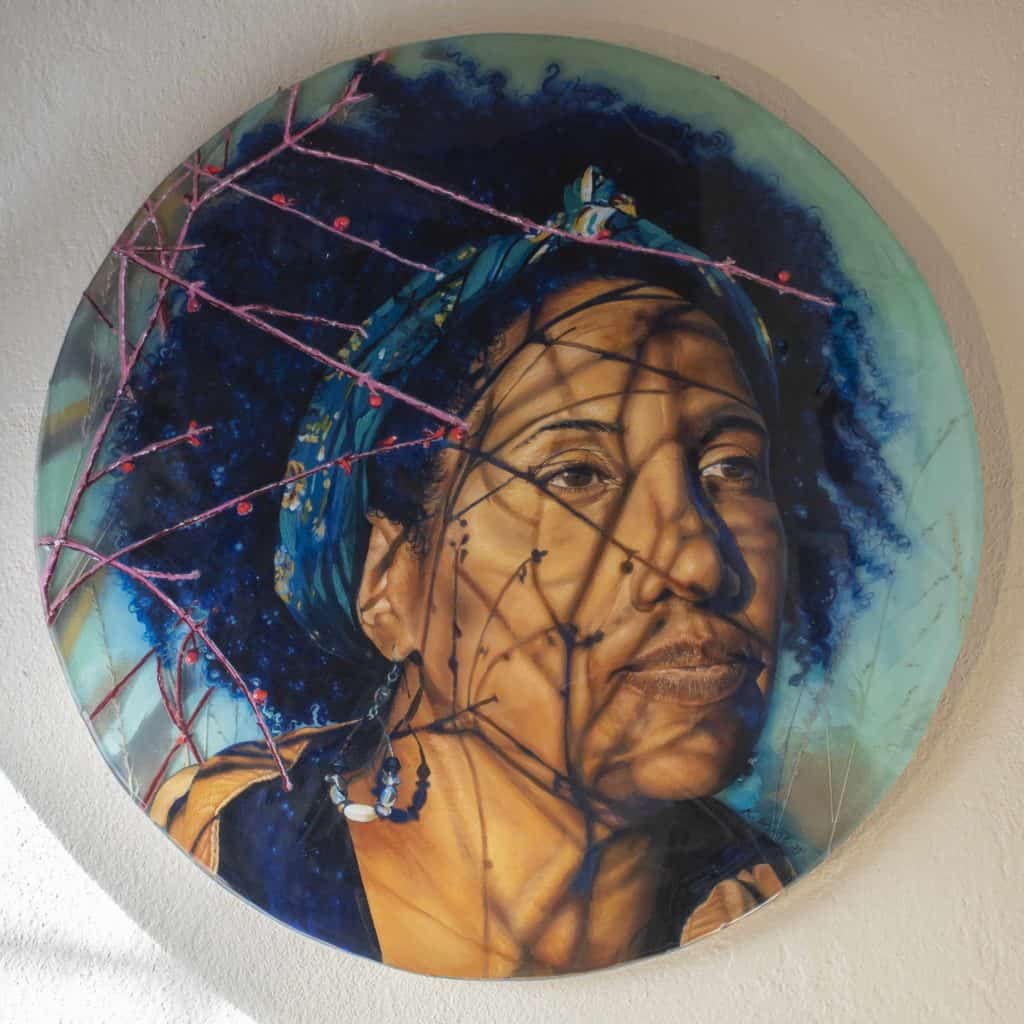Watch now: Exhibition presents striking portraits of Black Nebraskans
by L. Kent Wolgamott via the Lincoln Journal Star

The title of her Kiechel Fine Art exhibition, “i made the cornrows: portraits of Black Nebraskans,” is a takeoff on an experience artist Katharen Wiese had at age 15 and a pun on the crop that is most associated with the state she calls home.
Wiese, who is multiracial, walked into the fast-food restaurant where she worked while in high school with a section of her hair styled in cornrows, leading a co-worker to exclaim “Oh, my God, you are Black.”
That experience a decade earlier partially inspired the work in her first solo exhibition, a collection of evocative, visually striking prints and paintings she’s done of friends, family and Black community members.
“I was thinking a lot about the propagandizing of the Black figure that you often see during times of protests,” Wiese said. “You’ll see like a little girl on top of a car, or you’ll see a Black Power fist, or you’ll see this kind of image of a Black person that’s a little nameless, it’s a little faceless. And the Black figure sort of loses an identity.
The title of her Kiechel Fine Art exhibition, “i made the cornrows: portraits of Black Nebraskans,” is a takeoff on an experience artist Katharen Wiese had at age 15 and a pun on the crop that is most associated with the state she calls home.
Wiese, who is multiracial, walked into the fast-food restaurant where she worked while in high school with a section of her hair styled in cornrows, leading a co-worker to exclaim “Oh, my God, you are Black.”
That experience a decade earlier partially inspired the work in her first solo exhibition, a collection of evocative, visually striking prints and paintings she’s done of friends, family and Black community members.
“I was thinking a lot about the propagandizing of the Black figure that you often see during times of protests,” Wiese said. “You’ll see like a little girl on top of a car, or you’ll see a Black Power fist, or you’ll see this kind of image of a Black person that’s a little nameless, it’s a little faceless. And the Black figure sort of loses an identity.
“So I was thinking about how you make an image, which brings agency back to the figure, back to the individual that’s being represented, in a way that says something not just about what you’re thinking, but also about what that individual thinks about themselves.”
To create those images, Wiese interviewed her subjects, asking them a series of questions about what is most important in their lives, and then photographed them to create reference images for her paintings.
That technique was influenced by painter and sculptor David Manzanares, with whom she worked at the South of Downtown Community Development Organization when he was creating the two-story mural at 11th and G streets in the midst of the COVID-19 pandemic two years ago.
“I saw his process before I started this work, and he was interviewing people on the block,” Wiese said. “They were bringing him photos of their loved ones who’d passed away and he used all these images in this beautiful, monumental mural that ended up meaning so much to the community because the people on that block saw their family members on this giant wall.
“The work becomes so much more meaningful and so much more powerful when the people in the images have a stake in it and when the community has a stake in the images you’re representing.”
Community is, in fact, as important to Wiese as the individuals whom she is representing in her paintings.
“I love Lincoln, and I love Nebraska, and I love being a Black Nebraskan,” she said. “There can be a tense relationship. But, ultimately, I’ve been very supported and encouraged by a lot of my teachers and educators from the beginning, and I’m really grateful.”
Wiese, who says she knew she wanted to be an artist from the time she was 5, spent a year in the Lincoln Public Schools Arts & Humanities Focus Program, graduated from Lincoln North Star and, in 2018, earned her Bachelor of Fine Arts from the University of Nebraska-Lincoln, where her emphasis was in printmaking.
Community is, in fact, as important to Wiese as the individuals whom she is representing in her paintings.
“I love Lincoln, and I love Nebraska, and I love being a Black Nebraskan,” she said. “There can be a tense relationship. But, ultimately, I’ve been very supported and encouraged by a lot of my teachers and educators from the beginning, and I’m really grateful.”
Wiese, who says she knew she wanted to be an artist from the time she was 5, spent a year in the Lincoln Public Schools Arts & Humanities Focus Program, graduated from Lincoln North Star and, in 2018, earned her Bachelor of Fine Arts from the University of Nebraska-Lincoln, where her emphasis was in printmaking.
Wiese’s exhibition is momentous for the 26-year-old.
“She’s officially the holder of the youngest solo show at the gallery,” Kiechel said. “She’s the biggest 20-something-year-old artist currently in Nebraska.”
The pandemic delayed the show, but the extra time allowed Wiese to hone her craft and become a more well-rounded artist, Kiechel said.
“You can really see the improvement, the development in her work over the last year,” he said.
While the majority of the pieces in “i made the cornrows” date from 2020 to just a few weeks ago, there are a few that come from Wiese’s college work, including 2017’s “Sister Act.”
Wiese’s first “light painting,” which surrounds the image with colored light bulbs, portrays a pair of young Black women in the poster of the classic film “White Christmas.”


“I love the movie ‘White Christmas.’ Me and my sister would watch it together religiously,” she said. “I watched it again as an adult and I realized there are no people of color in the movie. The only time you ever see a Black person is when you see their hands serving.
“I was thinking about what it meant for me as a young woman, watching media that didn’t represent me, or that didn’t represent people that looked like my mom. And so I was, like, what would it mean to re-imagine that?”
Wiese appears in the self-portrait “undeniable presence” and in “our favorite was yellow (the Lovings),” a tribute to the Virginia couple who, in 1967, won a Supreme Court case that struck down Virginia’s ban on interracial marriage. Rendered far darker than her skin color in the painting, she sits beside her husband, Scott.
Weise’s mother, Charlette Harrington, is the subject of the exhibition’s most striking piece, “between spaces,” a glossy, round, oil-and-spray paint work with resin-covered prairie grass crossing her face.


It’s also a work that demonstrates how Wiese visually translated her interviews.
“In my mom’s portrait, there’s actually no black used in the painting,” she said. “It’s all really deep blues, because she identifies really deeply with her spirituality and her faith. And race isn’t something that’s a big part of her self-conception. And so how do you honor that experience, while also talking about it in the context of a larger Black narrative?”
As can be seen in the photographs and texts on a gallery wall, “i made the cornrows” is an ongoing project.
Wiese will be attending grad school at the Yale School of Art, where getting accepted as one of the 20 incoming painting students is the art equivalent of being a first-round NFL draft choice.
Wiese will join Phoebe Little, another Lincoln native and UNL grad, at the Ivy League school.
“That’s huge,” Holz said. “Am I beaming about that, having two of our graduates at Yale? You bet I am. It makes you feel good when people around you succeed.”
The Kiechel exhibition runs through May 15.
